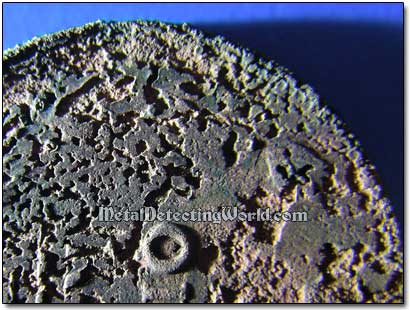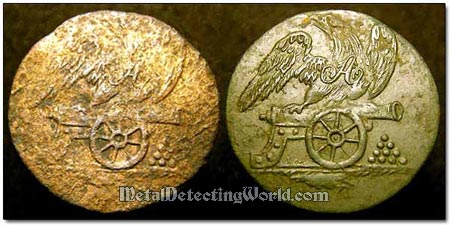How To Clean Coins and Jewelry with Electrolysis - A Detailed Tutorial, page 3
2) Is Cleaning Coin and Jewelry with Electrolysis Always Practical?
(...CONTINUED from Previous Page)
Shown below is an example of what became of the severely corroded copper coin after the electrolysis removed the verdigris encrustation off it: all coin details had been consumed by corrosion and now are impossible to read.
Damaged Coin's Surface Up Close

2) Electrolysis mercilessly removes the coin's "healthy" patina which is not only a sign of the coin's "antiquity", but also gives the coin a pleasant aesthetic look and character.
3) If the coin's details have become a part of encrustation, it is best to preserve the coin "as is". Removal of the corrosion coating will lead to a bare metal, featureless surface.
4) Encrustation is an insulator, so it is hard to establish a good electric contact between the coin and both the cathode and electrolyte unless you remove the crust off two small spots on the coin; thus, taking a high risk of accidentally scratching the specie and inflicting irreversible damage on it.
Avoid using electrolysis for cleaning the severely corroded copper-base coins and consider using a method of long soaking in olive oil instead, or other copper coin cleaning methods described on page 17 of my "Guide to Cleaning Coins". Same goes for any non-silver coins except gold coins that do not require any cleaning but simple rinsing in water in 99.9% of all cases.
With the only exception of coinage with silver content below 20% (many billon coins), silver coins are ok to be cleaned by the electrolysis; however, they should be frequently checked during the process. Proceed with high caution while cleaning those silver coins that have pewter, tin or aluminum - easily corroded metals, in their alloys.
The hard-to-clean coins should be subjected to other cleaning methods first, and the electrolysis should be only your "last resort". Rare coins of high numismatic value should be excluded from any amateur cleaning and must be treated by a professional conservator.
Electrolytic cleaning can damage the coin only if the coin is attached to the wrong electrode. Below is a picture of two buttons placed next to each other for comparison: a button on the left was destroyed by wrong electrode placement, the button on the right was partly cleaned without using electrolysis, just by brushing after it had been soaked in olive oil for two days.

Electrolysis cannot undo any damage caused by various forms of oxides, sulfides, carbonates, chlorides and verdigris, but it can:
• remove the hardest encrustation;
• remove corrosion coatings from inside the tiniest details where other means could not clean well;
• avoid scratches which would occur with mechanical cleaning;
• avoid removal of more coin metal than necessary in contrast to some chemical treatments;
• allow for the coin cleaning with minimal manual labor
3) ELECTROLYTIC CLEANING OF JEWELRY
You can clean your jewelry successfully with this powerful method at home using just common household products, but you need to make sure you have made a right decision in subjecting your valuable pieces to electrolysis. Make sure you know what your jewelry is made of. Do not use the electrolysis for cleaning cheap gold- and silver-plated jewelry! Also keep in mind that you should NOT put any silver jewelry containing porous stones, such as turquoise, shells or pearls into the electrolytic cell if you do not wish to destroy them. Consider using alternative methods for cleaning silver that are described on page 16 of my "Coin Cleaning Guide", or the commonly used jewelry cleaning supplies.
Before zapping the grime coated silver pieces, first try simpler methods such as immersion into Lemon Juice/Olive Oil Hot Bath or Electrochemical Reduction Cleaning. Although both the electrochemical and electrolytic cleaning methods are capable of removing the tarnish-causing chlorides and sulfides from the silver jewelry, the electrolysis should be left for the last, just like in most cases of coin cleaning.
Electrolytic cleaning is practical for the silver jewelry pieces that have a lot of small details and crevices in them that other methods have failed to clean well. After the electrolytic cleaning process is over, place your jewelry pieces into a baking soda/distilled water paste (2:1) to neutralize any chemical reactions that may be still going on. Then add some Pepsodent toothpaste to this paste and polish the silver pieces with a soft toothbrush, followed by rinsing.
How To Extract Gold from Gilded Jewelry
One of the best ways to extract gold from the gold plated jewelry pieces (or other items) is to use the electrolysis. The only conceptual difference between the gold removal and tarnish removal techniques is that the former has a gold plated piece attached to the ANODE instead of cathode (in the coin cleaning procedure). A stainless steel object is used as CATHODE, and the electrolyte is the high concentrated Sulfuric Acid.
The voltage of 12 Volts should be applied, so a regular AC/DC adapter would probably be sufficient. If not, use a car battery charger that can also provide a direct electric current of 24 volts and higher amperage.
The gold extraction process is based on solubility of gold in Persulfuric Acid. When the voltage is applied, the Sulfuric Acid covering the anode turns into the Persulfuric Acid, and the gold is dissolved in it. As soon as positive ions (cations) go into the electrolyte, the Persulfuric Acid turns back into the Sulfuric Acid, and the gold precipitates to the bottom. As soon as all gold is separated from the object and precipitated, a sharp decrease in amperage of electric current will occur - the process will be over.